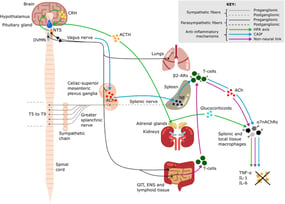How do the anti-inflammatory pathways of the Vagus Nerve work?
The anti-inflammatory capacities of the vagus nerve are mediated through three different pathways:
- The hypothalamic-pituitary-adrenal axis (HPA)
- Cholinergic anti-inflammatory pathway
- Splenic sympathetic nerve
Figure 1: systematic summary of the three anti-inflammatory pathways (Mastitskaya et al., 2021)

The hypothalamic-pituitary-adrenal axis (HPA) axis:
The HPA axis, that is activated via the afferent fibres (Bonaz, Sinniger and Pellissier, 2017), is an interactive, negative-feedback neuroendocrine system comprising the hypothalamus, pituitary gland, and adrenal glands and plays a key role in the basal homeostasis of the body (Heaney, 2013).The VN stimulates the HPA axis and is responsible for the release of glucocorticoids from the adrenal glands (Bonaz, Sinniger and Pellissier, 2017).
The hypothalamus responds to basal neural input by increasing the secretion of corticotropin-releasing hormone (CRH). An increase in CRH triggers the anterior pituitary gland to secrete adrenocorticotropic hormone (ACTH), which in turn circulates to the adrenal cortex to stimulate the release of cortisol into the bloodstream (Heaney, 2013).
The HPA axis has a wide range of functions associated with cortisol, including (Heaney, 2013):
- metabolism
- vascular activity
- immune and inflammatory responses
The Cholinergic Anti-inflammatory Pathway (CAP):
The job of the vagus nerve or parasympathetic nervous system is not only to balance the sympathetic nervous system and promote homeostasis but also to balance the levels of good (anti-inflammatory) and bad (pro-inflammatory) cytokines via two pathways (Martins et al., 2021).
CAP employs the vasovagal reflex which involves a brainstem-integrated communication between the afferent and efferent fibers (Bonaz, Sinniger and Pellissier, 2017).
CAP is mediated via the vagal efferent fibers that synapse onto enteric neurons and release ACh at the synaptic junction with macrophages. ACh binds to macrophage α-7-nicotinic ACh receptors and inhibits the expression of the pro-inflammatory cytokine, TNF-α (Breit et al., 2018).
The CAP has a unique property (Breit et al., 2018):
- The high speed of neural conductance enables an immediate modulatory input to the affected region of inflammation.
CAP plays a crucial role in the intestinal immune response and homeostasis, and presents a highly interesting target for the development of novel treatments for inflammatory diseases (Breit et al., 2018).
The vagus-splenic pathway:
Normally the parasympathetic and sympathetic nervous systems have an opposite effect; however, in the vagus-splenic pathway, the association between the VN and splenic nerve is synergistic (Bonaz, Sinniger and Pellissier, 2017).
Norepinephrine is released from the splenic nerve and binds to the 𝛽2 receptors of the spleen’s T-lymphocytes, triggering the release of ACh, which in turn bind to the 𝛂7nAChR of the macrophages, inhibiting the release of TNF-𝞪 (Bonaz, Sinniger and Pellissier, 2017).
The Byond Healthcare knowledge hub is exists to share expert content about the vagus nerve and the benefits of vagus nerve stimulation, with a specific focus on non-invasive vagus nerve stimulation, with patients, healthcare providers and medical representatives.